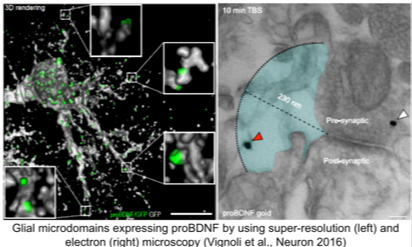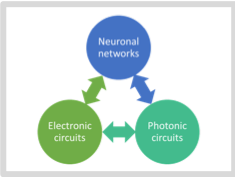Overview
Neuronal and synaptic ensembles (engrams) can be viewed as physical representations of learning and memory in the brain and might represent the cellular and sub-cellular bases through which memories are stored. In our laboratory, we moved away from neurons and focused on glial cells interacting with synaptic contacts (microdomains). How synaptic ensembles underlying the consolidation of neuronal circuits during learning are regulated by glial microdomains is the primary focus of our research.
Research directions
-
Neuron–glia interaction for memory consolidation
at the microscale, neural plasticity emerges as changes in the spatiotemporal pattern of activation of different synaptic components. While much attention has been given to pre- and post-synaptic sites for coordinating long-lasting synaptic strengthening; research in this regard has long time ignored the function of peri-synaptic glia (microdomains). These glial structures are ideally positioned to operate integrative functions by responding to synaptic demand and sensing the surrounding neuronal network activity. In the context of information and memory processing glial microdomains would then provide both local support over synaptic strengthening and overall control of synaptic ensembles (synaptic engram) engaged in memory circuits. This research hypothesis will be developed within the framework of the Progetti di Ricerca di Rilevante Interesse Nazionale (PRIN), Bando 2017 (Prot. 2017HPTFFC)
-
Photonics for circuit physiology
main focus of the project is to understand the relationship between connectivity and function in hybrid neuron/photonics systems. We will address this task by combining photonics as an ideal platform for optogenetic neural stimulation, dynamic imaging of neuronal activity and electrophysiological recordings. We will develop an integrated photonic-neuromorphic-computing platform for coding, consolidation, storage and retrieval of a memory trace created in vitro. The long-term vision is that hybrid neuromorphic photonic networks will control and supplement specific memory functions. This research topic will be developed within the framework of the European Research Council (ERC) under the European Union’s Horizon 2020 research and innovation program (grant agreement N° 788793-BACKUP).
Group members
- Marco Canossa, PI
PhD positions are available. Motivated candidates are encouraged to contact the PI.
Collaborations
- Lorenzo Pavesi, Department of Physics/Nanoscience Laboratory, University of Trento, Italy
- Paolo Bettotti, Department of Physics/Nanoscience Laboratory, University of Trento, Italy
- Beatrice Vignoli, Department of Physics/Nanoscience Laboratory, University of Trento, Italy
- Piergiorgio Carmignoto, Department of CNR Neuroscience Institute/Biomedical Sciences, University of Padova, Italy
- Gabriele Losi, Department of CNR Neuroscience Institute/Biomedical Sciences, University of Padova, Italy
- Antonino Cattaneo, SNS Pisa, Italy
- Enrico Cherubini, EBRI Rome, Italy
- Bai Lu, Govern Institute for Brain Research, Tsinghua University, China
Selected publications
Vignoli B, Battistini G, Melani R, Blum R, Santi S, Berardi N, Canossa M. (2016) Peri-Synaptic Glia Recycles Brain-Derived Neurotrophic Factor for LTP Stabilization and Memory Retention. NEURON. Nov 23;92(4):873-887.
Zuccaro E, Bergami M, Vignoli B, Bony G, Pierchala BA, Santi S, Cancedda L, Canossa M. (2014) Polarized expression of p75(NTR) specifies axons during development and adult neurogenesis. CELL REPORTS. Apr 10;7(1):138-52.
Bergami M, Vignoli B, Motori E, Pifferi S, Zuccaro E, Menini A, Canossa M (2013). TrkB signaling directs the incorporation of newly generated periglomerular cells in the adult olfactory bulb. THE JOURNAL OF NEUROSCIENCE, vol. 33, p. 11464-11478.
M. Bergami, S. Santi, E. Formaggio, C. Cagnoli, C. Verderio, R. Blum, B. Berninger, M. Matteoli, M. Canossa (2008). Uptake and recycling of pro-BDNF for transmitter-induced secretion by cortical astrocytes. THE JOURNAL OF CELL BIOLOGY, vol. 183, p. 213-221.
Bergami M, Rimondini R, Santi S, Blum R, Götz M, Canossa M (2008). Deletion of TrkB in adult progenitors alters newborn neuron integration into hippocampal circuits and increases anxiety-like behavior. PROCEEDINGS OF THE NATIONAL ACADEMY OF SCIENCES OF THE UNITED STATES OF AMERICA, vol. 105, p. 15570-15575
